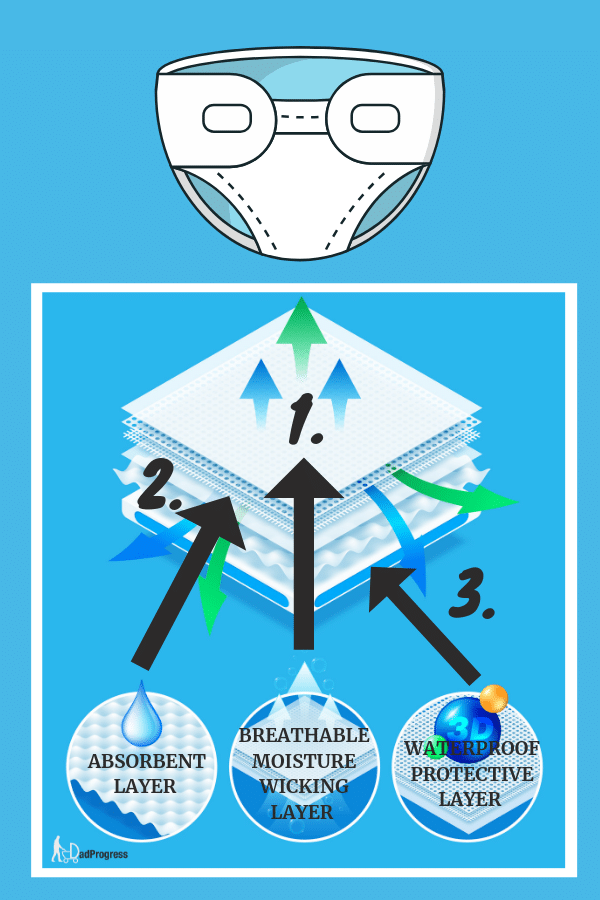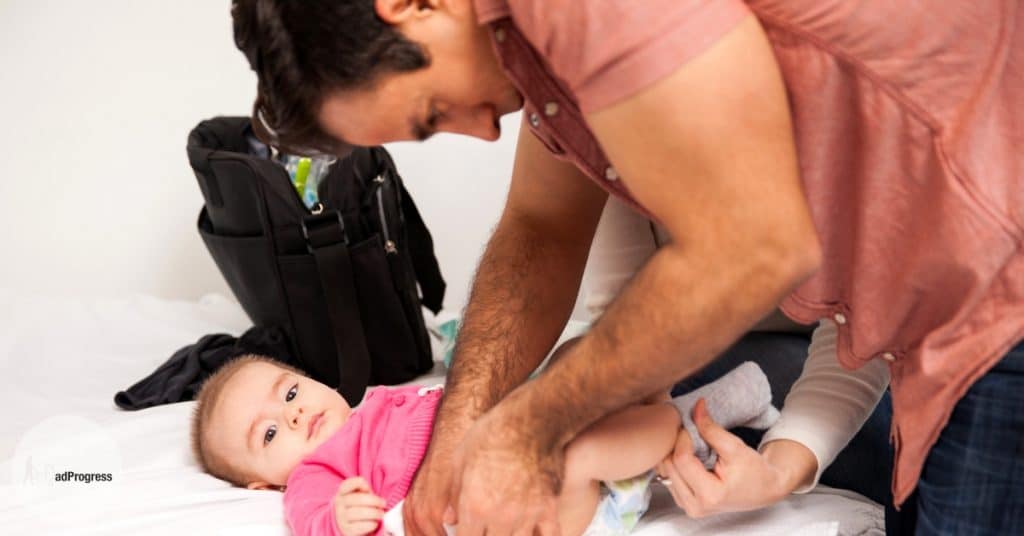Last Updated on October 28, 2019
As a new father who enjoys hiking and the outdoors, I am always looking for an earth-friendly solution to any problems if an alternative is available. This led me to research the “Cloth Diapers vs. Disposable” debate in detail to come up with a well-rounded essay that others may appreciate.
In the end, we didn’t opt for reusable diapers, but they may be the best option for many parents.
So keep reading to learn more about the topic!
Diaper Types
Although there are two major categories of diapers, disposable and washable, these two branches have many variations.
Because the working principle of swimming diapers is different, I’ve written a separate article about them.
Cloth Diapers 101
The original cloth diapers were just flat fabric cloths that were deftly folded and secured with “safety pins.” These diapers are called “flats” and were in use even during the 1800s.
Many evolutions followed as designers replaced the “safety pins “with snap enclosures, and started to sew them into shapes such as the hourglass shape that is so popular today.
Some cloth diapers also have different layers, which are explained more detailly in the next paragraph.
As a result, modern reusable diapers are very different from those that your great-grandma used.
Layers Of Cloth Diaper
The working principle of modern cloth diapers is very much similar to hiking clothes- it’s all about the layers.

Moisture Wicking Layer
Some manufacturers insert a separate moisture-wicking layer that will keep your baby’s skin relatively dry. This will help to prevent diaper rash. Many absorbent materials have similar properties, so this layer isn’t a must.
Absorbent Layer
Even if you don’t have any kids yet, you can probably guess that this is the most crucial layer:) Traditional cloth diapers use the cloth (muslin, cotton, etc.) for absorbency. For example, your great-grandma had to fold a flat so that at least four layers of material would be in the central area.
That said, microfiber and bamboo are more popular choices for this layer. Bamboo has antimicrobial properties that arguably makes it better suited for diapers than other materials.
It’s worth noting that pocketed and all-in-one diapers allow you to remove the insert, so you don’t have to wash the whole thing.
Waterproof Layer
You have two choices here. If you opt for a more traditional reusable diaper, then you need to buy a cover. A cover is like a raincoat for hikers, but the aim is to keep moisture in so that the outer clothes don’t get wet.
Another option is to buy a cloth diaper type that has a waterproof outer layer. Laminated polyester fabric is a popular choice here.
As a rule, pocketed and all-in-one diapers have a waterproof outer layer.
Types Of Cloth Diapers
Flats – the traditional cloth diapers that have to be folded into a form-fitting shape and secured with safety pins. They are large square or rectangular pieces of absorbent fabric that can you can wash and reuse over and over again. As I’ve noted (sorry for repeating myself), you would have to fold them for proper use.
Prefolds – These diapers are a lot like flats but are pre-folded and layered for better absorbency in the center. The design often features 4 to 6 layers in the center and 2 to 4 on the edges to maximize the absorbency where it is needed. Flats have to be folded into the same pre-fold shapes to achieve adequate protection. Therefore, pre-folds save time and are also easier to store because of their more compact and usable form.
Shaped – Shaped diapers are not very popular but were engineered into different shapes such as triangles and various letter pattern shapes for a better form fit. Nevertheless, pre-folds are still much more popular.
Contoured – Your commercial disposable diapers are a lot like contoured pre-folds. They have an hourglass shape that reduces the excess bunches of the diaper for a snugger fit.
Tie-ups – These diapers are like flats but have to be folded using a particular method to make use of string attachments that fasten and secure the diaper in place. These can be confusing, and parents don’t commonly use them today.
Fitted – These diapers go the distance. They are closest to the mass-produced disposable diapers in design. They have the form-fitted hourglass shape, elastic leg bands, and are secured with velcro or snap enclosures. These also descend into subtypes that such as pocketed, no-enclosures, and fitted diapers that are made from pre-folds. It’s worth noting that this type is made only of absorbent material.
Pocketed – The idea is that you change only the absorbent layer, which goes into the “pocket “between the inner moisture-wicking layer and outer waterproof layer.
All-in-ones – These diapers add an outer waterproof layer of fitted diapers and may also be found in pocketed styles with absorbency inserts.
Disposable Diapers 101
Commercial disposable diapers are lightweight and compact because they use human-made materials. I’ve already discussed the basic layered construction of cloth diapers.
Disposable diapers have the same layers, but they use different materials.
For example, the superabsorbent polymers are much more absorbent than any cloth diaper. My kid proved (by accident) that a disposable diaper can absorb about 38oz of liquid.
Types Of Disposable Diapers
Standard – These are your typical hourglass-shaped diapers that are secured with an adhesive around the waist. They also may have elastic at the legs to contain leaks.
Preemies – A preemie diaper is designed for premature babies and, thus, come in smaller sizes. They may also have a notch cut out for the umbilical cord to healing without irritation and discomfort from the waistband.
Pull-ups – These diapers go on like underpants and may have elastic bands at the legs and waist to secure them. They are easy for toddlers to run around in on the go without the bulkiness of standard diapers.
Training Pants – Much like the pull-up, these larger diapers are pulled up and down like underwear. They are often used for potty training but provide the protections of a diaper. They have a cloth construction that also makes them more like cloth diapers.
Pros and Cons of Disposable Diapers
When weighing the pros and cons of disposable diapers, it’s best to stay objective and not talk about “hidden dark side to the convenience and superior sanitation of these products “
PROS:
Time– Disposable diapers save you a lot of time. You don’t have to worry about washing cloth diapers and making sure that you always have enough inserts (if you use all-in-ones).
I admire people who use reusable diapers, but if you are a working parent, then the time may be your most valuable asset. Don’t let the peer pressure of 100 mommy blogs get to you and make your own decision!
If you have very little time (like we have), don’t make your life even more stressful. You can read a post by Meghann on what it actually means to use cloth diapers.
Convenience – Disposable diapers make it easy to change a baby anywhere on the go. You don’t have to worry about where you will store that dirty diaper and how many noses it may offend. They are also super sanitary and make it easy to feel clean at all times.
Long-lasting protection – If your baby pees while they are sleeping, your disposable diaper will likely contain the mess without any discomfort or diaper rash until you can change them in the morning. For parents who are on the go, baby’s maximum comfort and rest can mean the same for the parents. Overnight disposable diapers are even engineered for this purpose.
Comfort– Disposable diapers are more comfortable for your kid that the traditional cloth diapers. That may backlash has he or she may not incline to potty train. That said, you usually can’t train an under a one-year-old anyway so why not to make the life good for him or her?
CONS:
Disposable – Because the diapers are disposable, you won’t be able to keep using them for generation after generation. Once they are soiled, they can’t be reused.
Expensive – Disposable diapers cost more. That said, the difference isn’t that big when it comes to the cost of disposable vs. cloth diapers. I’ve seen many mommy blogs cite “$1,000 to $1,500 every year, “and I’m thinking like “meh? “
If you buy a Pampers mega-box from Amazon, then you pay 0.27c or less for a diaper. It’s worth checking the latest price though. Even if you change diapers like ten times a day (for a one-year-old it’s already less), it’s still less than $1000 a year.
If you use all-in-one cloth diapers, then you may want to buy about 30, so you don’t have to wash them every time. Bumgenius is a popular choice, but they cost about $20 each which means about $600 for a patch.
Sure, after two years it will be about $1900 vs. $600, but again… what’s your time worth?
Environmental Footprint – Although disposable diapers are about 40 percent biodegradable, they are filling up landfills and contributing to pollution. It can take more than 500 years for a disposable diaper to decompose into its base elements fully. The petroleum, plastics, perfumes, dioxin, and wood pulp all take a toll on the environment.
Although producing cloth is also taxing on the environment, we can make an educated guess that disposable diapers really are more harmful to mother Earth
Pros and Cons of Cloth Diapers
When it comes to cloth diapers, they require some special accommodations.
PROS:
Safe and Natural – If you use traditional cloth diapers that only contain plant fibers, there is nothing toxic that can leach into your baby’s skin or irritate their respiratory systems. There are no perfumes or dyes unless you add them yourself.
Reusable and Economical – You can hand down your cloth diapers for generations and generations. This makes them valuable for a large family. Cloth diapers may cost as little as $100 (if you use flats) to stock up on and reuse for the entire infancy. But as I’ve already noted, more modern (that are more comfortable and convenient options) cloth diapers can cost about $600.
Stylish – Because cloth diapers look more like ordinary clothing, some brands can look like they are designed for aesthetic purposes. That said, they are usually bulkier than disposable diapers
CONS:
Environmental Impact – Although cloth diapers are not leaving behind landfill waste, they may be using up a lot of water and energy to clean them. My educated guess is that all options are still less taxing on Earth than disposable diapers.
Flats are probably the option when it comes to environment-friendliness, but they are also the least comfortable are require more of your time than other options.
Travel – When you are out and about, you may need a large ziplock baggie to store stinky diapers to contain the odors.
Time– As I’ve already pointed out (sorry for repeating myself), this option is more time-consuming
Bulky– Most reusable diapers are more cumbersome than their disposable counterparts so you may need to buy bigger clothes
Less Protective– Leakage is a problem with many reusable diaper brands
Summary: Cloth Diapers vs. Disposable
I wrote this article so that all dads and moms could make a more informed decision (so no peer pressure here). Although I like that the reusable diapers are more environment-friendly and a little cheaper than the disposable, they aren’t the best choice for us. We simply don’t have enough time for them. They may also not be the best option if you have to travel a lot. So we ended up using Pampers diapers that are also sold on Amazon.
That said, two thumbs up to all parents who can make them work!

